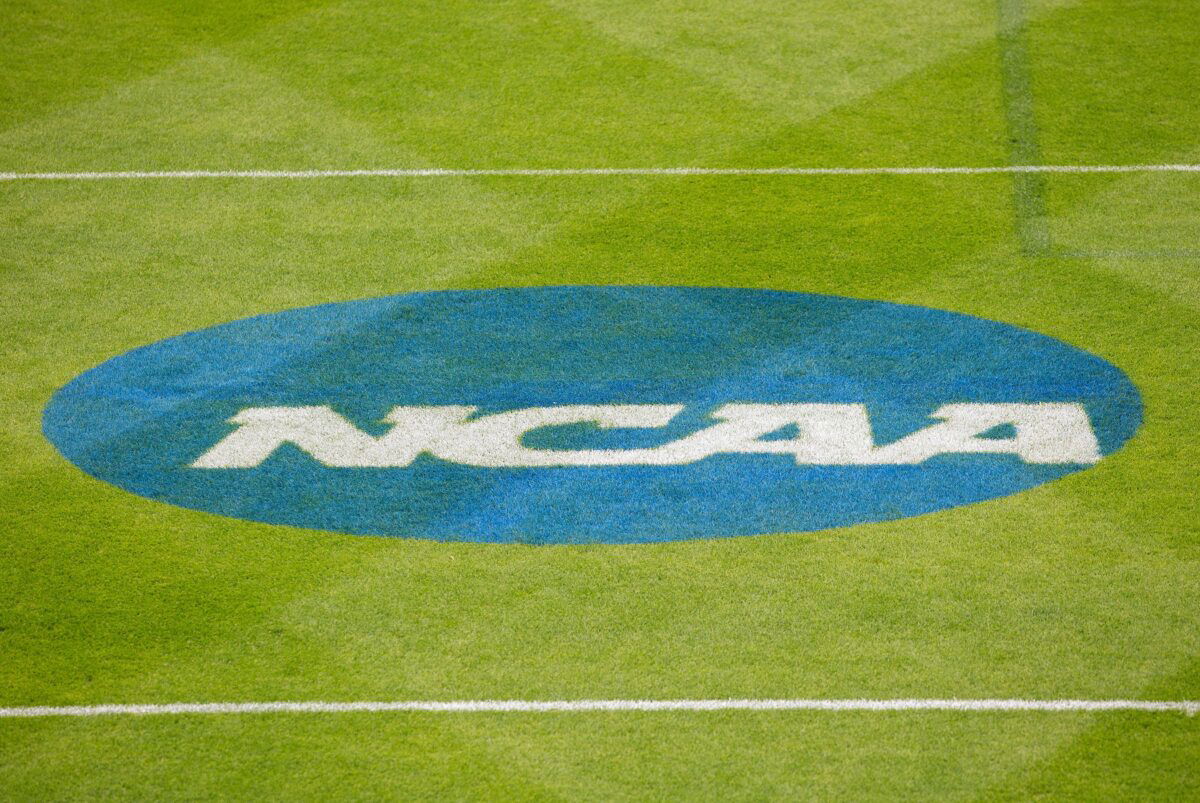
Imago
EAST HARTFORD, CT – MAY 19: General view of the NCAA, College League, USA logo prior to the Division 1 quarterfinal game between Loyola Greyhounds and Penn State Nittany Lions on May 19, 2019, at Rentschler Field in East Hartford, CT. (Photo by M. Anthony Nesmith/Icon Sportswire) NCAA LACROSSE: MAY 19 NCAA Lacrosse Championships Quarterfinals – Loyola v Penn State PUBLICATIONxINxGERxSUIxAUTxHUNxRUSxSWExNORxDENxONLY Icon19051913

Imago
EAST HARTFORD, CT – MAY 19: General view of the NCAA, College League, USA logo prior to the Division 1 quarterfinal game between Loyola Greyhounds and Penn State Nittany Lions on May 19, 2019, at Rentschler Field in East Hartford, CT. (Photo by M. Anthony Nesmith/Icon Sportswire) NCAA LACROSSE: MAY 19 NCAA Lacrosse Championships Quarterfinals – Loyola v Penn State PUBLICATIONxINxGERxSUIxAUTxHUNxRUSxSWExNORxDENxONLY Icon19051913
They thought NIL would be a victory lap, but it might just be a disguise in blessing form. That after July 1, everyone would play nice, collect their checks, and the NCAA would finally find its peace. Instead? 11 days in, and the whole NIL world is on fire. The so-called “House Settlement” that was meant to regulate fair play has turned into a legal battlefield, with authorities shutting down collectives and parties already loading lawsuits. And at the center of this chaos is the NCAA’s new favorite enforcement: the College Sports Commission.
Watch What’s Trending Now!
Let’s break this madness down.As part of the House v. NCAA settlement, which took effect on July 1, a new watchdog group called the College Sports Commission (CSC) was established. Their job? Scrutinize NIL deals above $600. All deals have to pass through a clearinghouse called “NIL Go,” where Deloitte-designed algorithms determine if they’re legit. Two magic phrases now rule the NIL world: “valid business purpose” and “fair-market value.” If your deal doesn’t check those boxes? Bye.
That’s exactly what happened to dozens of NIL collectives. According to guidance issued Thursday, the CSC said most collective-backed deals don’t cut it. Why? Because their whole mission is just… paying athletes. The CSC wrote, “An entity with a business purpose of providing payments or benefits to student-athletes or institutions, rather than providing goods or services to the general public for profit, does not satisfy the valid business purpose requirement.” Translation: If your entire business is just throwing donor money at athletes? The CSC thinks that’s not a real business.
ADVERTISEMENT
Just 11 days into the House Settlement and there’s already chaos.
The new College Sports Commission says most NIL collective deals don’t serve a valid business purpose and won’t be approved.
That effectively bans collectives from making NIL deals… and now attorneys say it…
— Adam Breneman (@AdamBreneman81) July 12, 2025
That ruling hit like a freight train. On July 11th, Former All-American Adam Breneman dropped a bomb on X, tweeting, “The new College Sports Commission says most NIL collective deals don’t serve a valid business purpose and won’t be approved. That effectively bans collectives from making NIL deals… and now attorneys say it violates the settlement. Nearly 100% of collective-backed deals are being denied right now. Because “pooling donor money to pay athletes” doesn’t meet the CSC’s definition of a real business. This isn’t just messy — it’s a direct challenge to the NIL ecosystem that’s fueled college sports the last 3 years.” And now? The lawyers are circling.
House attorneys, led by Jeffrey Kessler and Steve Berman, didn’t waste time. They fired off a heated two-page letter Friday addressed to the NCAA’s legal head honcho Rakesh Kilaru. They also copied in the Big Ten, Big 12, SEC, ACC. In that letter, they claimed the CSC’s guidance is flat-out “undermining” the House settlement. “There is nothing in the Settlement Agreement,” Kessler’s letter reads, “to permit the CSC to decide that it would not be a valid business purpose for a school’s collective to engage in for-profit promotions of goods or services using paid-for student-athlete NIL.” In short: just because the collective exists to promote athletes doesn’t make it illegal — not if they’re promoting something.
ADVERTISEMENT
The letter didn’t pull punches. It accused the NCAA and the CSC of applying the rules unfairly — that they’re picking on collectives for doing what countless other businesses do: pay athletes for appearances, promotions, and brand deals. And here’s the twist — this dispute might now go before federal Judge Nathanael Cousins, the man tapped to referee any legal drama tied to the House settlement. If he agrees with Kessler? The NCAA could be staring down a major embarrassment. If he doesn’t? NIL collectives might be toast.
ADVERTISEMENT
NIL Gatekeepers or Overreach Gone Wild?
Here’s where it gets messier. The CSC and NIL Go aren’t random suits. They’re backed by the very schools that cut the House deal. The power conferences — yes, the ones now getting side-eyed by lawyers — created the CSC and gave it teeth. Their goal? Rein in NIL madness and transition athlete payments from booster collectives to school-run revenue sharing.
That might sound noble on paper. But in practice, it’s cutting off the legs of an entire ecosystem. Collectives like The Fund or Rising Spear have operated in the gray zone for years, funding players through donations and brand deals. But as of now, NIL Go has flagged about 80 of 2,000 submitted deals — with more rejections reportedly coming. Still, schools and collectives have approved over 1,500 NIL deals. So the system isn’t fully clogged.
Top Stories
Andy Reid Announces Patrick Mahomes’ Injury Diagnosis as Chiefs HC Doesn’t Hold Back After Playoffs Elimination
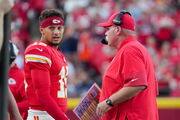
Former US President Joe Biden Keeps a Clear Demand to Eagles Owner Amid Jalen Hurts’ Struggles
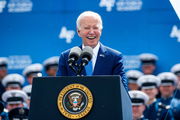
Cowboys Star Risks Severe Punishment Over Justin Jefferson Incident vs Vikings
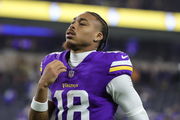
A’ja Wilson, Bam Adebayo Issue Strong Statement Against Rachel Nichols’ Question About Couple’s Privacy
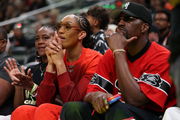
Diego Pavia Issues Public Statement After Heisman Controversy Triggers Strong Reaction

Ex-Georgia Gymnastics Star Opens Up On Facing Mistreatment Months After NCAA Program Switch
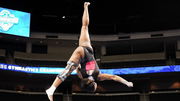
By nuking the collective model, the NCAA and conferences are forcing schools to pay athletes only through school-approved channels — which cap compensation at $20.5 million per year per school. That means schools want to kill off third-party collectives so they don’t have to worry about bidding wars. But here’s the rub: collectives were always the workaround. They let boosters fuel recruiting without hammering the schools’ official budgets. And they operated in broad daylight, with everybody —fans, coaches, players — understanding how the game was played.
ADVERTISEMENT
For now, athletes and collectives are in limbo. Schools don’t want to violate the rules. Collectives don’t know what counts as “valid.” And athletes? They just want someone to pay them without reading a 200-page legal memo. As Adam Breneman said: “Who knows what happens next.” He might be right. But one thing’s clear — the NIL era’s Wild West days aren’t over. They’ve just found new sheriffs. And not everyone’s buying what they’re selling.
ADVERTISEMENT
ADVERTISEMENT
ADVERTISEMENT

